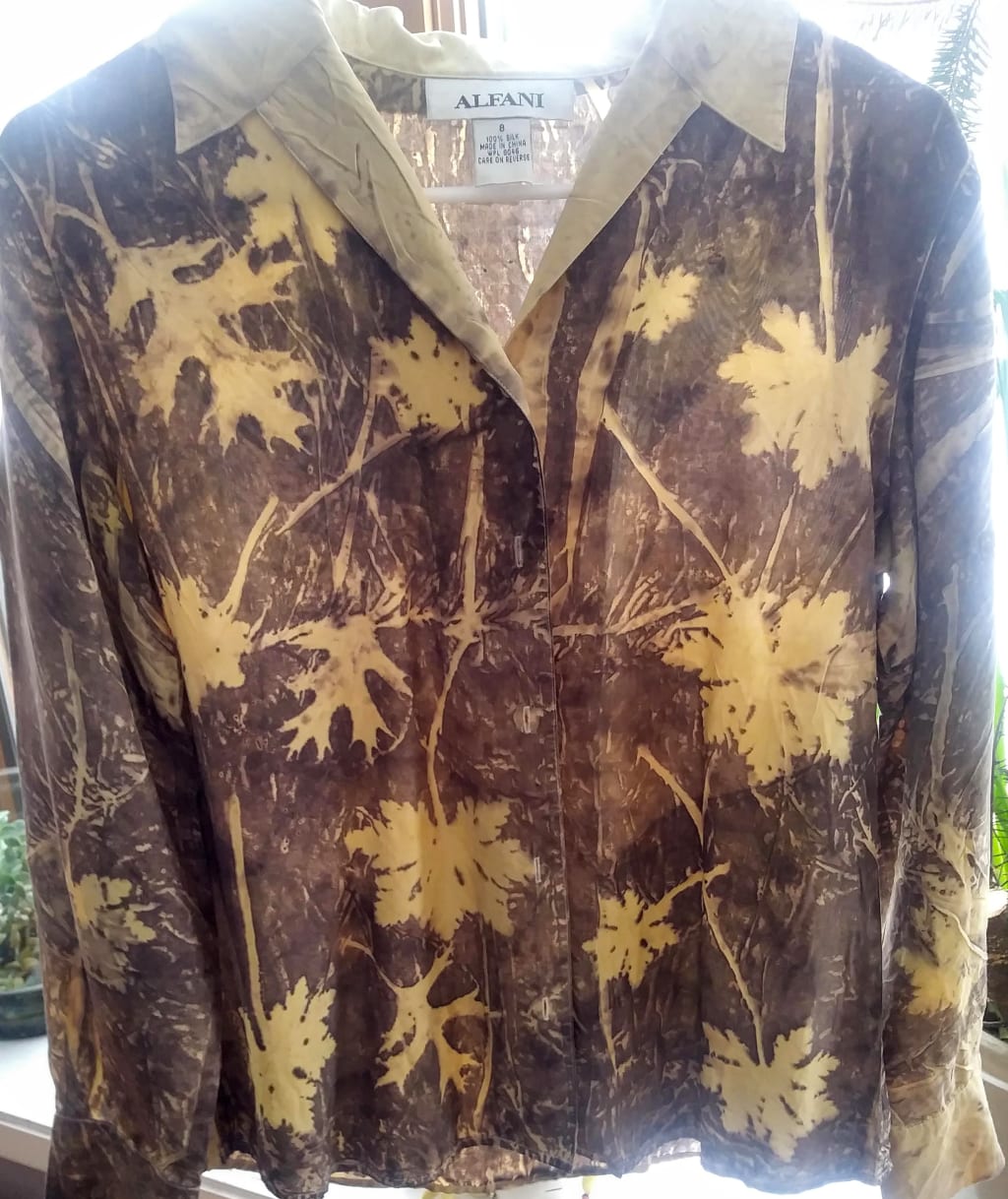
I have a business card with the name, Dyeing Heidi, on it. That’s me, or it was, back when I dyed on a daily basis. I thought it was funny to tell people that I was going to dye in the upcoming days. Today, it seems a little morbid. As time goes by, I find that my life overlaps more and more with those who experience dying in the true sense, so who am I to make light of death?
In the last five years, I have spent hours and hours scouring through thrift stores and flea markets for all sizes of colorless clothing and linens, which I later dye with plants and natural materials from my backyard. Finding a light-colored silk or wool item is very exciting, as the materials are animal fibers that easily absorb natural dyes; the final, dyed product almost always exhibits vibrant colors and prints. Other natural fibers, such as cotton or linen, also work with plant dyes, but one has to use more time-consuming methods to ensure that the dyed colors stay lightfast and colorfast on the revamped shirt or coat. Whatever the fabric, it’s fun to search through the racks of clothing for gently used garments to transform.
Until recently, items I've purchased and dyed don’t sit in my house very long. I sell them at local art and craft fairs or I gift them to friends and family. It has, however, been over a year since I’ve participated in an event, primarily due to the cancellation of fairs because of the pandemic. Hence, there is, stashed in the corner of my craft room, a clothes stand filled with dyed items and an additional three, overloaded racks of white clothing, along with numerous, untouched boxes of linens. To be clear, it is not only the pandemic stalling movement of the clothing, but the lack of inspiration and motivation, on my part, to dye them.
Because of this mass of clothing taking up space in my home, I have not visited the clothing racks at a thrift store in over a year. What should I do to get back into the groove of upcycling these garments into one of a kind naturally dyed items?
One factor, in favor of getting out the dye vats, is the weather. Spring is definitely here and using fresh leaves is much more enticing than using the dried leaves that I’ve stored in boxes, books and between cardboard sheets. The contrast between a crumbling, brown oak leaf and a supple, green one is indicative of new beginnings and life. Is there a better way to celebrate life than by layering fresh leaves and flowers in a dingy old tunic, rolling it around a wooden stick and then plopping it into a simmering dye bath of goldenrod?
It is now warm enough to set up on the back deck, where the view of the nearby cornfield and wooded area is splendid. Areas of green grass and buds are appearing all around. Plus, rhubarb is bursting from my garden bed and the leaves will soon be large enough to create a dye bath; the poisonous, yet helpful, rhubarb foliage aids in binding other plant colors to fabric. Dandelions, maple leaves, sumac and wild geraniums are just a few of the many plants that will soon be ready to harvest for the dye pot or steam bath.
I do miss going to thrift stores, but I promised myself I wouldn’t go back until I upcycle all the clothes languishing in my craft room. Much of the cookware used in the dye process was also purchased from flea markets and thrift shops. These metal vessels are piled in a basement corner, collecting dust and waiting patiently to be utilized again. Among them is a turkey roaster, found at a local flea market. Although it probably was used to deliver many moist and savory birds for consumption, it is now my favorite dye pan in which to steam fabric bundles that have been layered with leaves and blossoms.
The smells that waft from the turkey roaster during the dye process are sometimes heavenly, not exactly like the buttery onion and sage aroma of a roasting turkey, but oftentimes, a citrus, lemon scent fills the air or there could be any number of fragrant herbs added to the brewing concoction. Unfortunately, the odorous fumes are occasionally less than desirable, reminiscent of compost or manure. I prefer to dye outside.
All this talk of smelly dye pots and steamers has me looking forward to again pulling a leaf-bundled shirt out of a steaming turkey roaster and opening it to rediscover the magic of dyeing. I am Dyeing Heidi, sometimes a bit morbid, but excited to dye again.





Comments
There are no comments for this story
Be the first to respond and start the conversation.